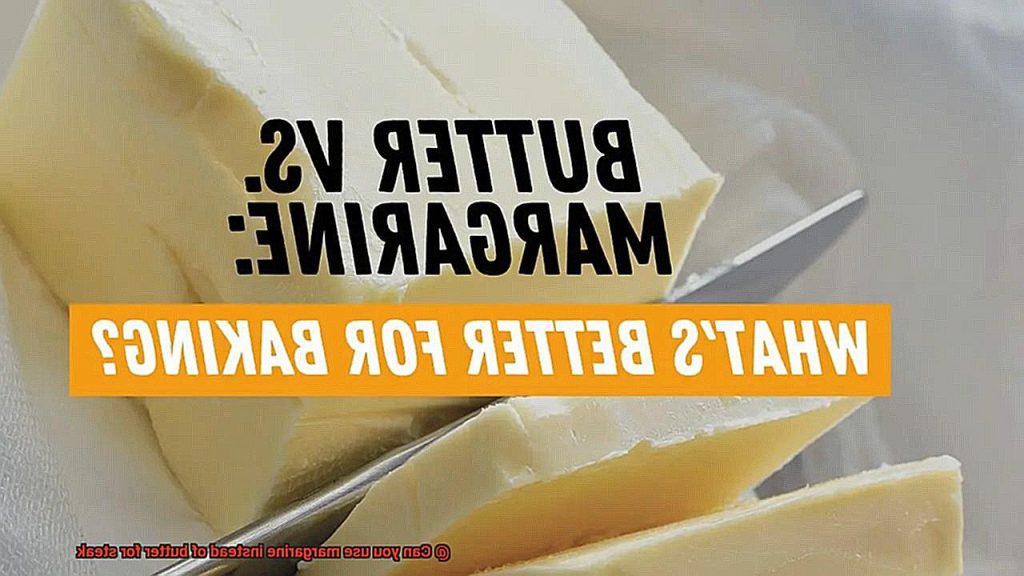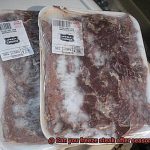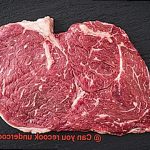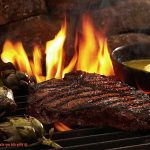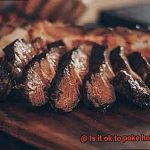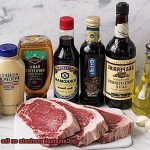Who doesn’t crave a perfectly seared steak, with its mouthwatering flavor and beautiful golden-brown color?
But have you ever found yourself without butter in your pantry or unable to use it due to dietary restrictions? Fear not, because margarine might just be the solution you need.
But can you really use margarine instead of butter for steak? In this blog post, we’ll explore the pros and cons of using margarine as a substitute for butter when cooking your favorite cut of meat.
We’ll dive into the key differences between these two ingredients and analyze how margarine behaves when exposed to high heat. We’ll also take a closer look at the flavor and nutritional profiles of both butter and margarine, helping you make an informed decision about which one is right for you.
So sit back, relax, and let’s get cooking with margarine.
Contents
What is Margarine?
Margarine is a beloved spread that has been enjoyed for centuries.
It’s a perfect substitute for butter, with some key differences in properties and composition. Crafted from vegetable oils, water, and other additives, margarine boasts a consistency and flavor similar to butter.
One of the most significant advantages of margarine is that it contains less saturated fat and cholesterol than traditional butter. This makes it an excellent option for health-conscious individuals looking to maintain a balanced lifestyle.
Additionally, margarine has a longer shelf life and can be stored in the refrigerator for several months. Margarine comes in various types, including tub margarine, stick margarine, and liquid margarine.
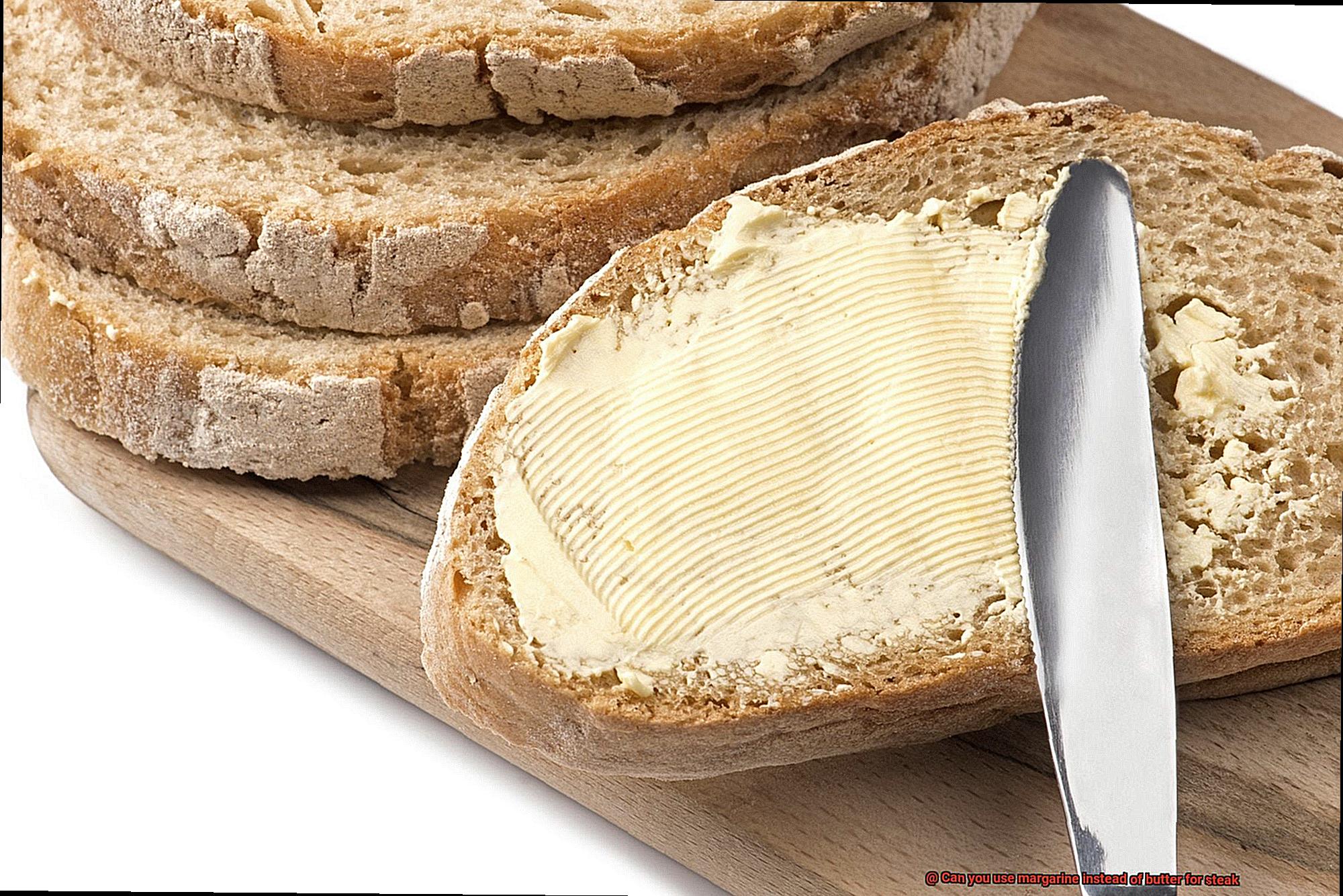
Each variety has distinct properties that make it ideal for different culinary applications. For instance, tub margarine is typically used as a spread on bread or toast, while stick margarine is well-suited for baking.
If you’re a steak lover looking to use margarine instead of butter when cooking your meat, there are some things you need to keep in mind. Margarine and butter have different properties, with margarine containing more water than butter.
As a result, you may notice some differences in texture and flavor when using margarine instead of butter. Another crucial factor to consider when cooking steak with margarine is the smoke point.
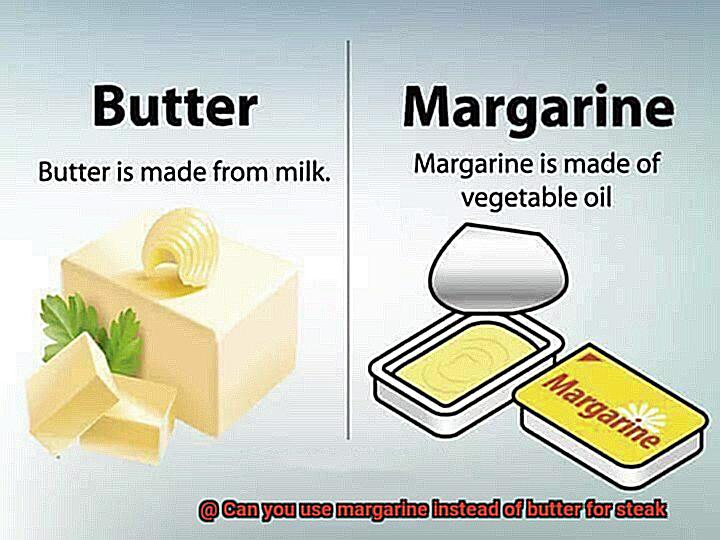
The smoke point is the temperature at which the oil or fat begins to break down and smoke. Different types of margarine have varying smoke points, so it’s crucial to choose one that can handle the high heat required for cooking steak.
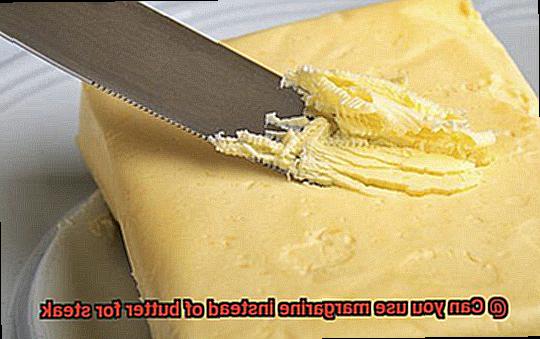
In conclusion, margarine is an exceptional alternative to butter that can be used in many different ways.
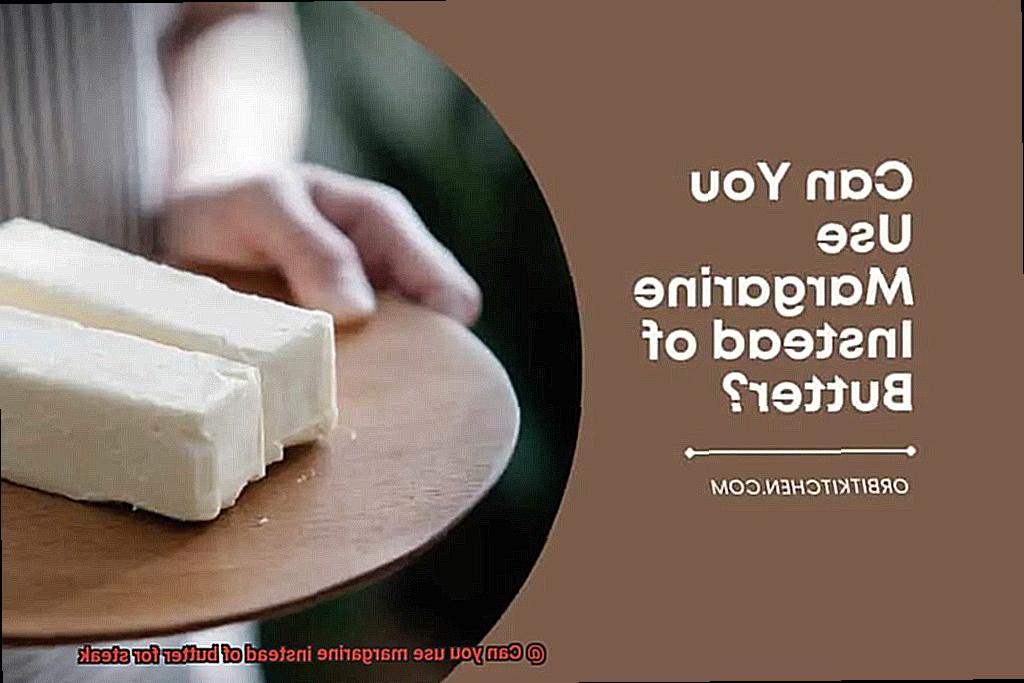
Properties of Margarine and Butter
Both spreads are used to add flavor to recipes and as a spread on bread, but they have distinct differences in properties.
Margarine is made from vegetable oils, while butter is made from milk fat, which affects their texture, flavor, and cooking properties. Margarine, being softer than butter at room temperature due to its higher percentage of unsaturated fats, has a more neutral flavor compared to the rich and creamy taste of butter.
It’s often used as a substitute for butter in recipes where a lighter texture or mild flavor is desired. Think fluffy cakes, cookies, and dairy-free options for those who are lactose intolerant or vegan.
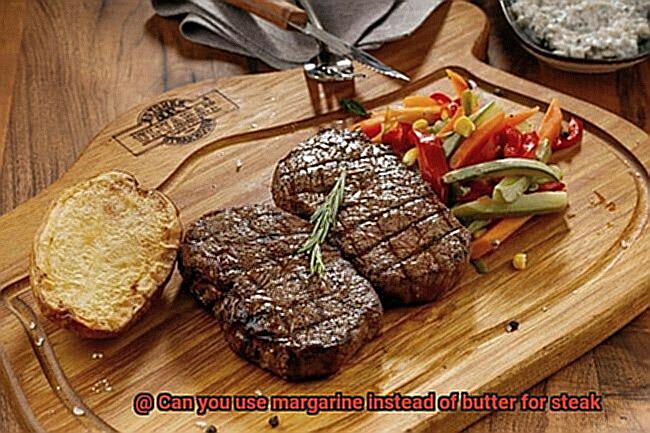
Butter, with its higher percentage of saturated fats, has a firmer texture and a more pronounced flavor. It’s often used in recipes where its rich taste is desired, such as in pastries, sauces, or on top of steaks.
It also contains vitamins A and D, which are not present in margarine. Speaking of steaks, both margarine and butter can be used as cooking fat to add flavor and prevent sticking to the pan.
However, some chefs prefer to use butter for its ability to create a caramelized crust on the steak during cooking. In summary, margarine and butter have distinct properties that make them suitable for different purposes in cooking and baking.
Each spread brings its unique qualities to the table – margarine with its softness and neutral flavor and butter with its firm texture and rich taste.
How to Choose a High-Quality Margarine for Steak Cooking
Steak is a delicious and popular meal that many people love to prepare at home. While there are various ways to cook steak, using margarine can help enhance the flavor and texture of the meat. However, choosing the right margarine can be tricky. In this article, we’ll discuss five key factors to consider when selecting a high-quality margarine for steak cooking.
Choose Margarine Made with Natural Ingredients
When it comes to choosing margarine for cooking steak, it’s essential to look for a product made with natural ingredients. Margarines made with simple and natural ingredients, such as vegetable oil, water, and salt, are often the best choice. These types of margarines are less processed and contain fewer additives and preservatives. Plus, they’re usually lower in trans fats and saturated fats, which can be harmful to your health.
Consider Smoke Point
The smoke point is a crucial factor to consider when choosing margarine for steak cooking. The smoke point refers to the temperature at which the oil or fat in the margarine begins to break down and produce smoke. If you cook steak at high temperatures, you want to choose a margarine with a high smoke point. This will help ensure that the margarine doesn’t burn or produce an unpleasant smell or taste.
Look for Low Saturated and Trans Fats
Saturated and trans fats can be harmful to your health and increase your risk of heart disease and other chronic conditions. When choosing margarine for steak cooking, look for a product that’s low in saturated and trans fats. Instead, opt for margarine made with healthy oils like canola oil, soybean oil, or olive oil.
Flavor Matters
While some margarines may have a strong flavor that could overpower the taste of your steak, others can enhance the flavor of the meat. Look for a product that complements the flavors of your steak without overpowering them. Some margarines are flavored with herbs, spices, or other ingredients that can add depth and complexity to your dish.
Consider Clarified Butter or Ghee
If you’re looking for a margarine with a high smoke point for cooking steak, clarified butter or ghee is an excellent choice. Clarified butter is made by separating the milk solids and water from the butterfat, resulting in a product with a higher smoke point than regular butter. Ghee is a type of clarified butter that’s heated longer, giving it an even higher smoke point. Both options have a rich, nutty flavor that can enhance the taste of your steak.
In conclusion, choosing a high-quality margarine for steak cooking involves considering factors like natural ingredients, smoke point, low saturated and trans fats, flavor, and opting for clarified butter or ghee. By choosing the right margarine, you can ensure that your steak turns out delicious and healthy every time.
Benefits of Using Margarine Over Butter
Look no further than margarine.
This versatile ingredient can be used in place of butter and offers several benefits that make it a smarter choice. For starters, margarine is lower in saturated fat than butter, making it the perfect option for those who want to keep their fat intake in check.
Margarine also contains plant sterols that have been shown to lower cholesterol levels, making it a heart-healthy choice. But that’s not all.
Margarine has a higher smoke point than butter, which means that it can handle high heat without burning. This makes it ideal for cooking steak at high temperatures without sacrificing flavor.
Butter, on the other hand, has a lower smoke point and can burn quickly, ruining the taste of your meat. Margarine also has a longer shelf life than butter and can be stored in the fridge for several weeks.
This is a convenient option for those who don’t use butter regularly or want to avoid food waste. And let’s not forget about the cost.
Margarine is often cheaper than butter, making it an affordable option without sacrificing taste.
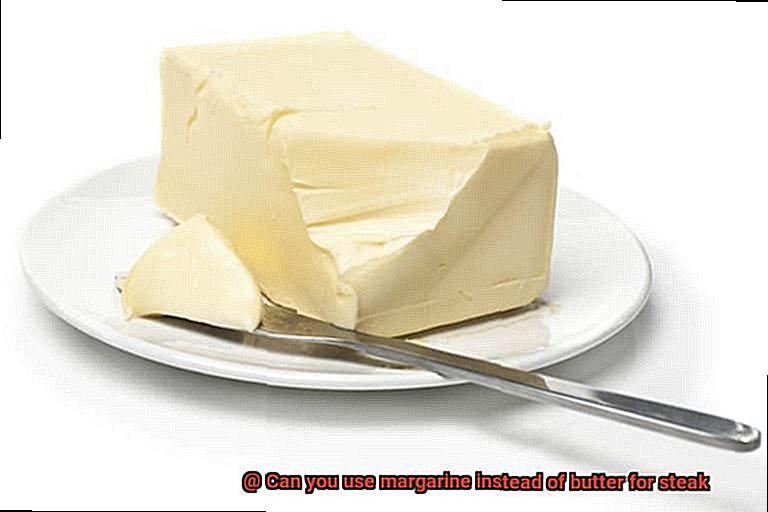
How to Cook Steak with Margarine
It’s a versatile ingredient that can add moisture and flavor to your meat. Here are five tips for cooking steak with margarine that will result in a mouth-watering meal.
Choosing the Right Margarine
Not all margarines are created equal, so it’s important to choose the right one for cooking steak. Look for a margarine that has a high smoke point and is specifically labeled as suitable for cooking. This will ensure that the margarine doesn’t burn or smoke excessively when heated.
Prepping Your Steak
Before cooking your steak with margarine, make sure it’s at room temperature and pat it dry with paper towels. This will help ensure that the steak cooks evenly and doesn’t become too watery. Plus, it’s like giving your steak a little spa treatment before its big moment in the skillet.
Cooking Your Steak
Heat up your skillet over medium-high heat and add a tablespoon or two of margarine. Once it’s melted and bubbling, add your seasoned steak to the skillet and let it cook for a few minutes on each side until it reaches your desired level of doneness. As the steak cooks, baste it with the melted margarine using a spoon or basting brush to keep it moist and flavorful.
Adjusting Your Seasoning
Since margarine is made from vegetable oils and often contains additives such as emulsifiers and flavorings, it may not provide the same rich flavor as using butter. That’s why it’s important to adjust your seasoning accordingly. Add a little extra salt, pepper, or even some herbs and spices to enhance the flavor of your steak.
Enjoying Your Delicious Steak
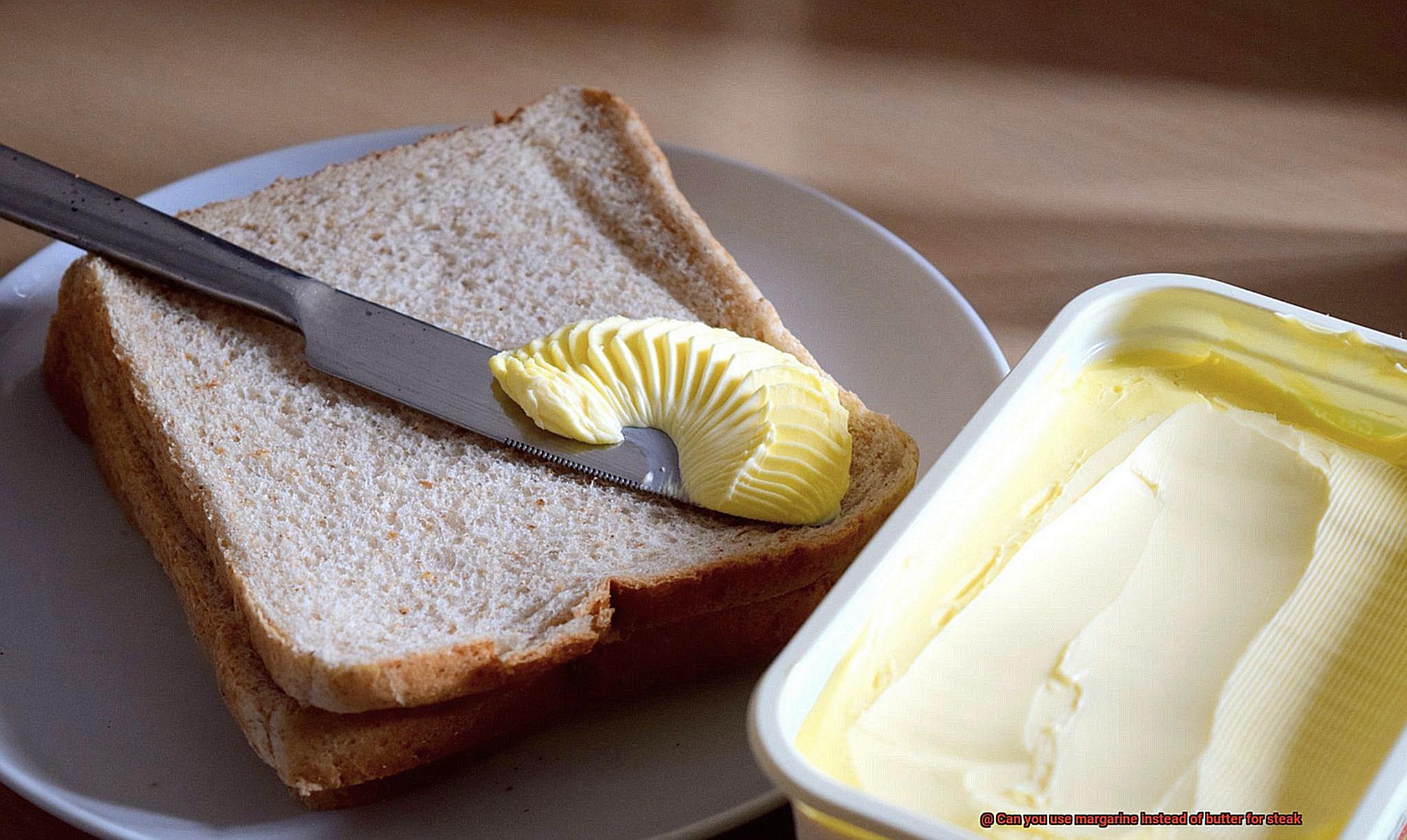
Once your steak is cooked to perfection, remove it from the skillet and let it rest for a few minutes before slicing and serving. Take a moment to appreciate all of your hard work and enjoy every juicy bite of your delicious steak cooked with margarine. Who knows, maybe you’ll even prefer it to butter.
In conclusion, cooking steak with margarine is a viable option as long as you choose the right type and adjust your seasoning accordingly. It may not provide the same rich flavor as using butter, but it can still result in a delicious and satisfying meal. So, don’t be afraid to experiment with different types of margarine and seasonings to find your perfect combination.
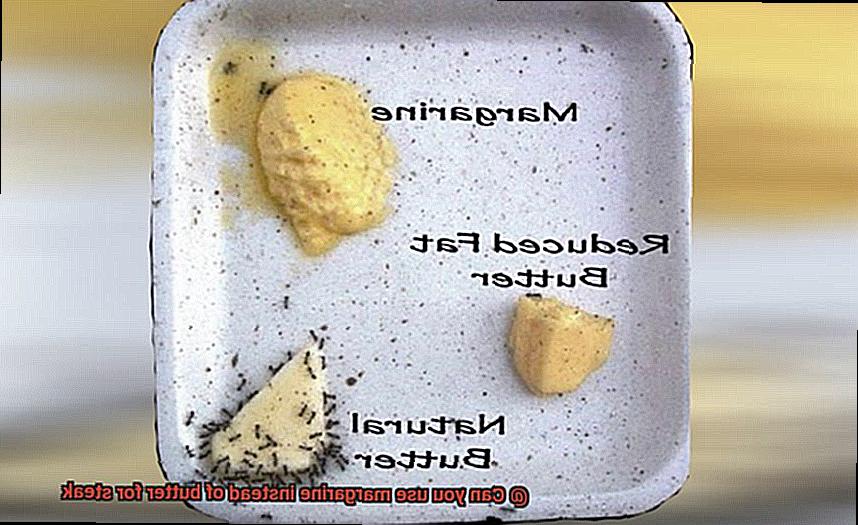
Tips for Cooking Steak with Margarine
Look no further than margarine. Cooking your steak with margarine can be a tasty alternative, but it’s important to keep a few things in mind. Here are seven tips for cooking steak with margarine that will help ensure a delicious and flavorful outcome.
Choose High-Quality Margarine
When selecting the margarine for your steak, opt for a high-quality, unsalted variety with at least 80% fat content. This will ensure that the margarine can handle the high heat required for cooking steak without burning or smoking excessively.
Season Your Steak
Properly seasoning your steak is crucial to its flavor. Rub the steak with salt and pepper, or your preferred seasoning blend, and let it rest at room temperature for at least 30 minutes before cooking. This allows the seasoning to penetrate the meat and helps ensure an even cook.
Use A Heavy-Bottomed Skillet Or Grill Pan
When it comes time to cook the steak, use a heavy-bottomed skillet or grill pan. Heat the pan over high heat until it is very hot, then add a small amount of margarine to the pan. Once the margarine has melted and started to foam, carefully add the steak to the pan.
Baste Your Steak With Margarine
As you cook the steak, basting it with the melted margarine using a spoon or pastry brush can help infuse the meat with flavor and keep it moist.
Cook To Your Desired Level Of Doneness
Cook the steak for approximately 3-4 minutes per side for medium-rare or longer if desired. Once the steak is cooked to your desired level of doneness, remove it from the pan and let it rest for a few minutes before slicing and serving.
Experiment With Toppings
Top your steak with any additional seasonings or toppings, such as garlic butter or sautéed mushrooms, to add extra flavor and texture.
Enjoy Your Delicious Steak
By following these tips, you can successfully cook a delicious steak using margarine instead of butter. Whether you prefer it rare or well-done, margarine can help create a juicy and flavorful steak that will be the star of any meal.
In conclusion, cooking steak with margarine can be just as delicious as using butter. By choosing the right margarine, seasoning your steak correctly, using a heavy-bottomed skillet or grill pan, basting your steak with margarine, and experimenting with toppings, you’ll be able to enjoy a perfectly cooked and flavorful steak every time.
vd0tbnh4lc0″ >
Conclusion
In conclusion, margarine is a fantastic alternative to butter when cooking steak.
Margarine has some unique benefits that make it a smarter choice for health-conscious individuals. It contains plant sterols that lower cholesterol levels, has a higher smoke point, and is often cheaper than butter.
Additionally, margarine is lower in saturated fat, making it an excellent option for those looking to reduce their intake of unhealthy fats. When selecting the right margarine for cooking steak, there are several factors to consider such as natural ingredients, smoke point, low saturated and trans fats, flavor, and opting for clarified butter or ghee.
Once you have chosen your preferred margarine type, there are several tips to keep in mind when cooking your steak. These include properly seasoning your steak, using a heavy-bottomed skillet or grill pan and basting your steak with margarine as it cooks to infuse it with flavor and moisture.

